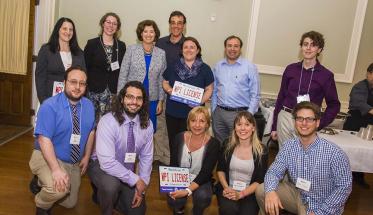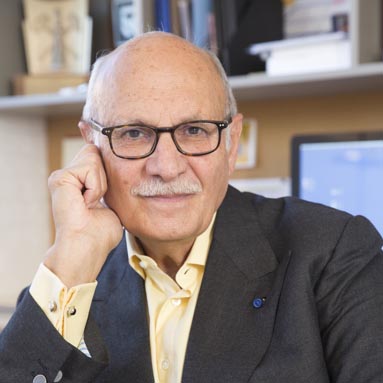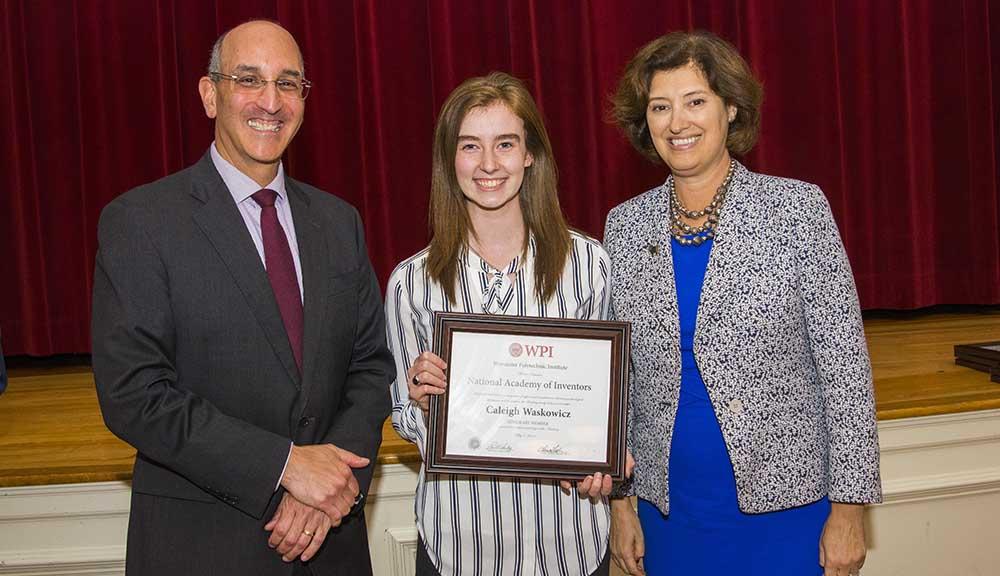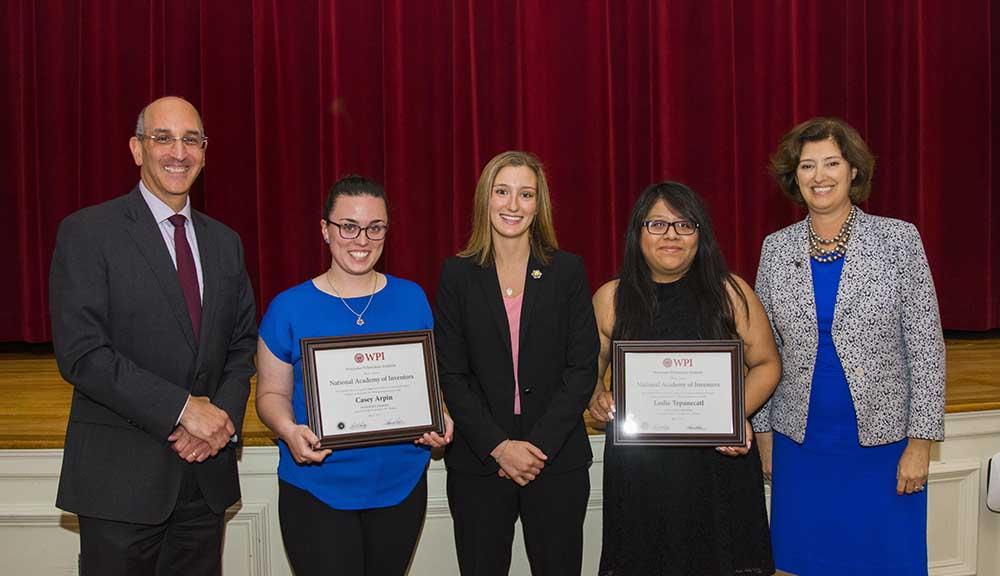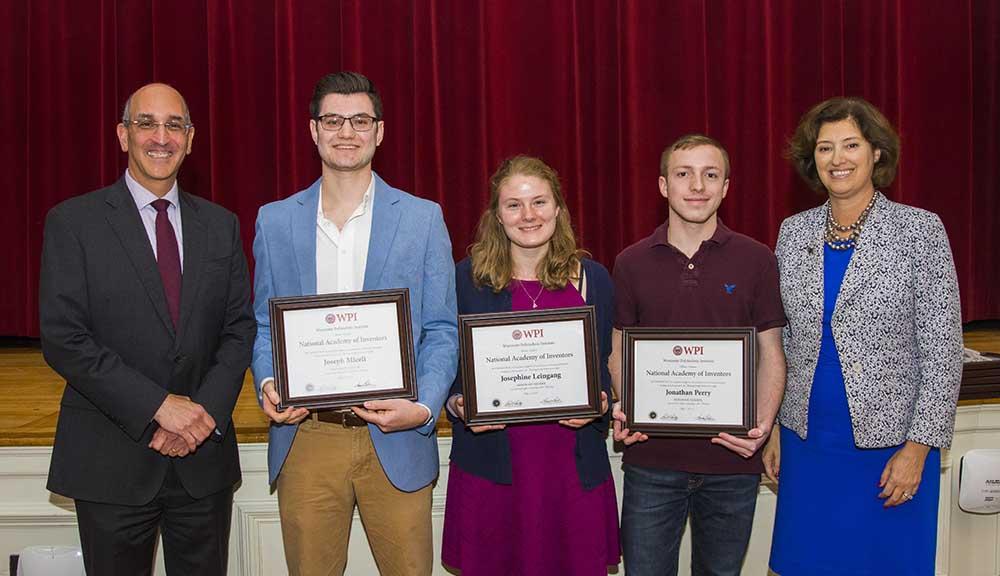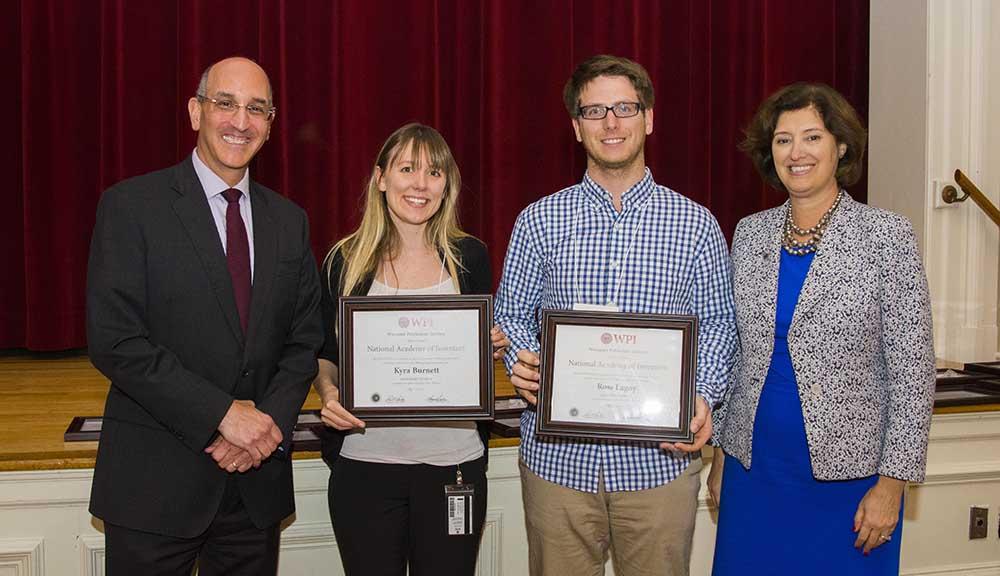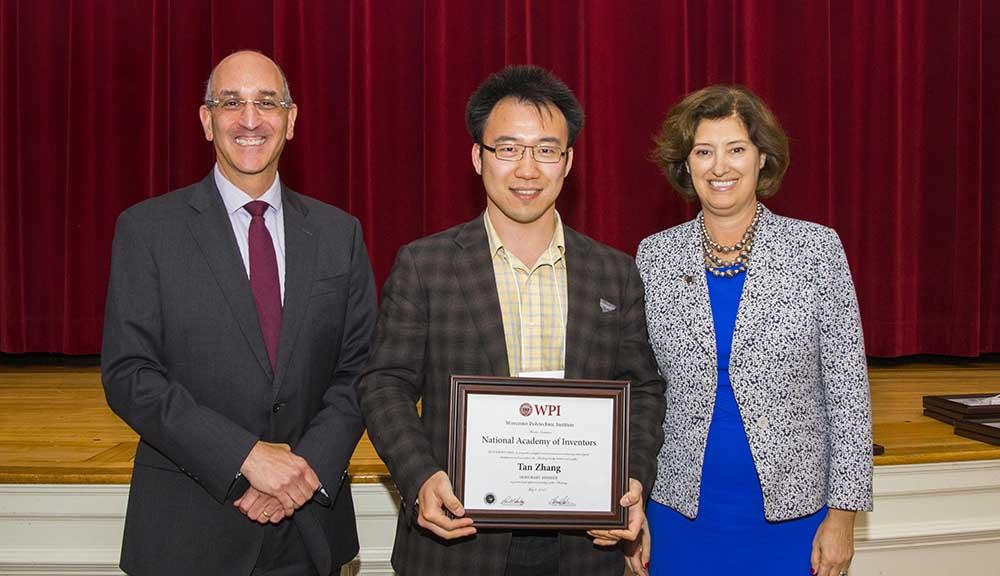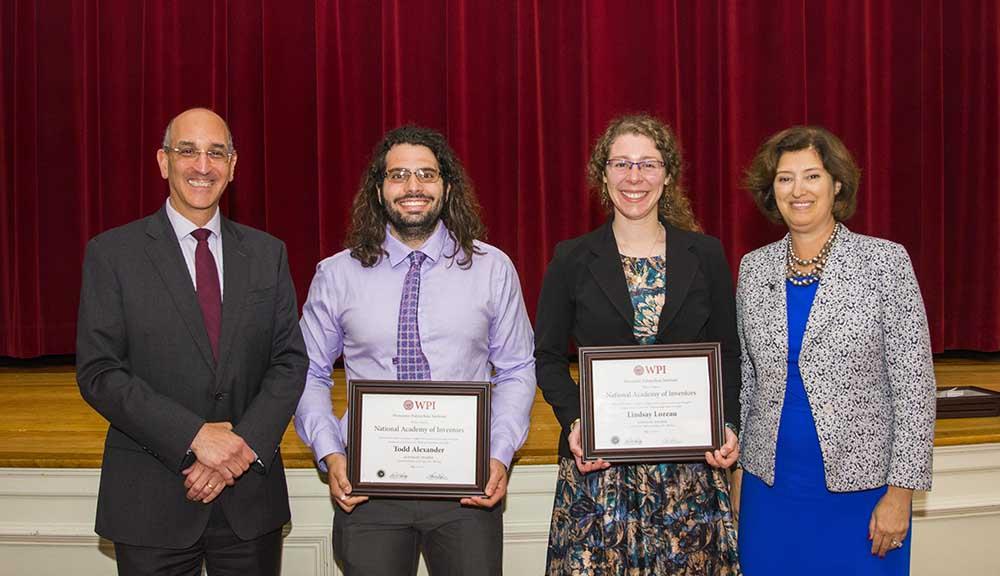WPI had a record number of students filing patents and receiving patent licenses over the last year, according to President Laurie Leshin, who spoke earlier this month at the annual meeting of WPI’s chapter of the National Academy of Inventors (NAI).
Drew Hirshfeld, commissioner for patents at the U.S. Patent and Trademark Office, delivered the keynote at the event, which included an awards ceremony where student and faculty inventors were honored and recognized.
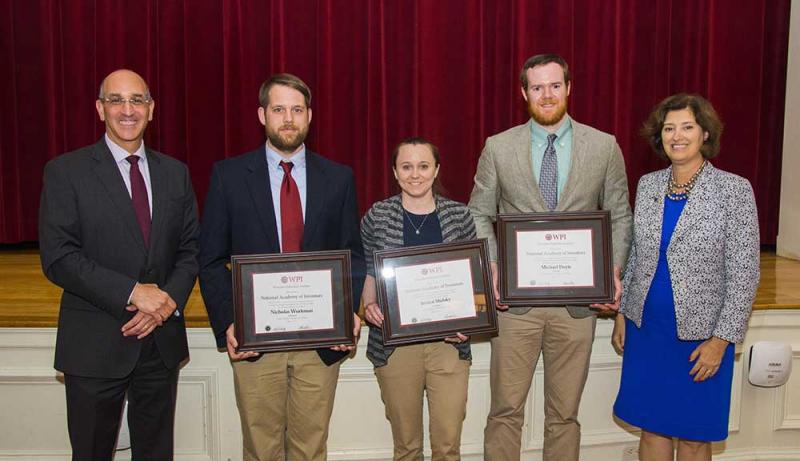
(L-R) Drew Hirshfeld, Nicholas Workman, Jessica
Shelsky, Michael Doyle, and Laurie Leshin
Leshin said that a record number of 16 patents were licensed last year involving 22 faculty members. Four new faculty members and four alumni were inducted into WPI’s NAI chapter. Additionally, a record five patents were licensed this year, and 42 students became honorary NAI members after filing for patents last year—the highest numbers in WPI’s history.
“I’m incredibly impressed with all of you,” Leshin told the group. “You are all trailblazers and path-makers for those who come after you.”
Students’ and faculty members’ ideas coming together is a huge opportunity for innovation, she said, adding, “We know that this kind of work will continue to rise and be front and center at WPI.”
Todd Keiller, WPI’s director of intellectual property and innovation, said the event showcased the previous year’s highlights in intellectual property and innovation at the university.
“Acknowledging the issued patents and making students who have applied for patents honorary members is great,” Keiller said. “However, my favorite is the award for licensing a patent. That shows we are on a commercial pathway that will, hopefully, result in a useful product that creates jobs.”
One of the WPI teams honored for its patent—Michael Doyle, Jessica Shelsky, and Nicholas Workman—came up with their idea while conducting their MQP (Major Qualifying Project).
Shelsky, who earned her master’s degree in 2014, said the team developed its MQP with mechanical engineering professor Chris Brown on preventing injuries to the knees when downhill skiing, using a boot that twists off. Shelsky, also an athlete, said the team developed the first prototype that they could test in 2011 before their MQP presentation.
“It was exciting towards the end when they told us, ‘This might be patentable,’” she said, during an interview after the NAI meeting. “Then they told us they were filing an application for a patent.”
The project fulfilled her MQP requirements in both her majors (biomedical engineering and mechanical engineering), she said. The prototype has been licensed to Brown’s company, Sports Engineering, Inc., which is further developing the prototype at WPI. The hope is that final prototypes will be available to show shoe companies by September.
“Professor Brown was willing to take on the project to fulfill the requirement in both departments,” said Shelsky, who now works as a manufacturing engineer at a medical device company.
She said the IQP (Interactive Qualifying Project) she completed in London was a great stepping stone for the MQP and “opened me up and helped me out.”
“Our names are on the patent as inventors,” she said. “It’s pretty crazy. I would love to be more involved with it. It is a great talking point and experience—the whole development and what you need to apply and working with the lawyers. It was a really good thing to go through and learn during the initial research. I’d love to do it again.”
“Our names are on the patent as inventors ... I would love to be more involved with it. It is a great talking point and experience—the whole development and what you need to apply and working with the lawyers. It was a really good thing to go through and learn during the initial research. I’d love to do it again.” -Jessica Shelsky
Hirshfeld said part of his role as commissioner is to foster innovation, and added that he likes the idea that WPI emphasizes the licensing of patents, not just patents for patents' sake.
“Events like this are wonderful. You are all the great minds on the other side of the paper and part of a larger ecosystem trying to help foster innovation,” he said.
Hirshfeld said he first learned about WPI from a colleague. “Then, I got to look at WPI,” he said. “It’s the greatest place. … WPI does a wonderful job putting students first—WPI goes the extra mile.”
Universities typically don’t do enough to teach about the patent process, he said, but with its emphasis on licensing and patenting, “WPI recognizes innovation.”
In 2016 a Department of Commerce study on intellectual property (IP) industries found that IP-intensive industries helped support 45 million U.S. jobs and contribute $6 trillion to gross domestic product—just under 40 percent of total GDP, he said.
Only about half of the 600,000 patent applications filed in a year are granted, he said. His office hires about 300 new examiners a year, he explained, adding that there are 8,000 examiners—4,000 of them working out of their homes—based on production. An engineering or science degree is required, he said, and the office will pay to send those interested to law school.
“I have no doubt WPI students would do well,” he said, adding the attrition rate after the first year is just 1 percent.
During the event, Provost Bruce Bursten recognized Professor Diran Apelian, who started at WPI as provost in 1990, as the university’s first inductee into the NAI Fellows Program.
Bursten, who called Apelian a “pioneer in materials processing,” said his induction into the program was the highest distinction given to academic inventors. NAI fellows hold 32,000 patents, he said. Apelian, the son of Italian and Armenian immigrants, holds 18 himself.
“It feels great,” Apelian said. “It is fabulous and humbling, but, as I said to some of my colleagues, it doesn’t define me. It is an important, great recognition and honor, but I don’t take myself that seriously, to be honest. Hopefully, I am an exemplar for others that you can take an idea in a laboratory and protect it, patent and license it.”
As he was speaking, a graduate student stopped to congratulate him and told him he looked up to him. The student asked Apelian if he would have lunch with him and mentor him, to which he agreed.
“I feel very strongly about the mentoring piece,” Apelian said, afterwards. “People mentored me and took me under their wing. I had literally nobody when I came to the U.S. I couldn’t even speak English. They must have seen something in me. It is all about mentoring and living a purposeful, meaningful, and fulfilling life. At the end of each day, I want to say I think did something good today and gave back.”
- By Paula Owen
